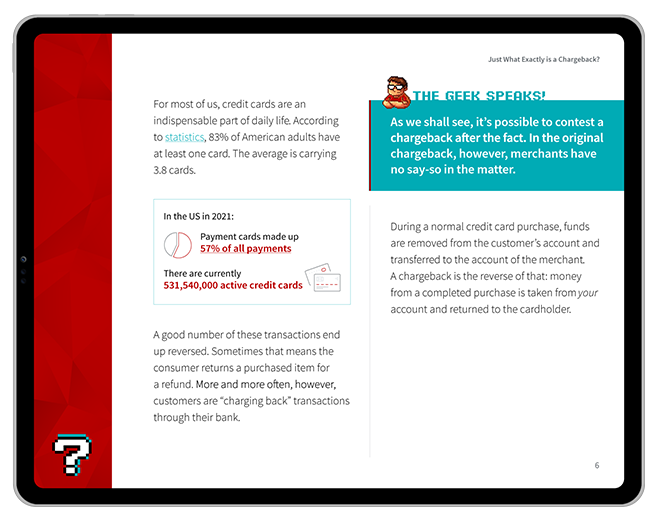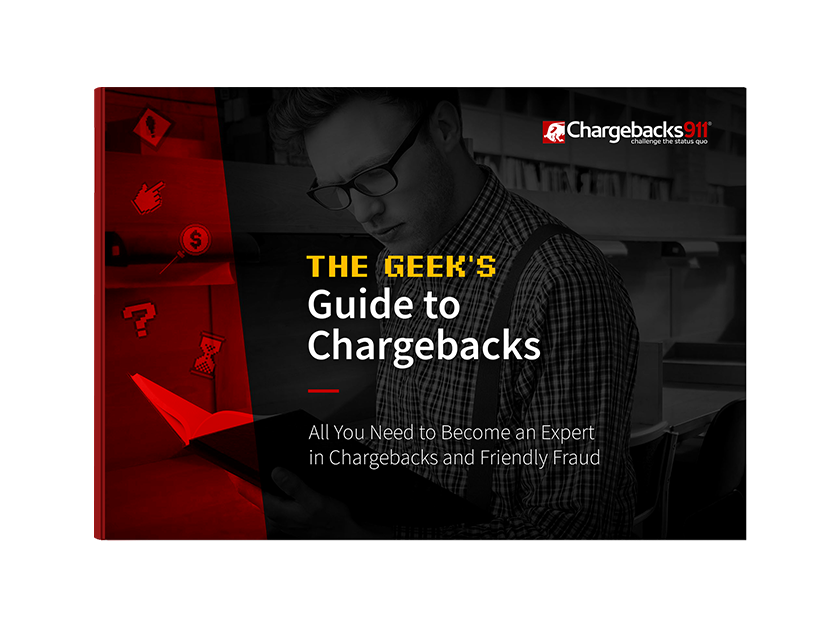6 Steps to Reduce Chargebacks & See Fast Relief From Disputes
While it’s true that chargebacks are a risk for any online business, many merchants view them as largely unavoidable. They simply accept their chargeback situation until the sheer volume of claims forces them to act. By that point, a lot of unnecessary damage has been done.
We say “unnecessary” because it’s actually possible to reduce one’s chargeback volume substantially. In fact, the average merchant can reduce chargebacks by 40% or more with relative ease. What’s required is a solid plan, specialized tools, and the right tactics. Above all, it will take time.
But there’s the rub: if your chargeback problem is already out of control, you may not feel that you have time. If you’re already facing long-term consequences due to chargebacks, you need to do something that will help right now. Fortunately, we can help.
Recommended reading
- The Top 30 Chargeback Risk Factors to Eliminate in 2024
- Can a Chargeback Blacklist Prevent Post-Transaction Fraud?
- Chargeback Insurance: Choose the Best Protection in 2024
- What is a Business Continuity Plan? Tips, Guides & Examples
- How Stripe Chargeback Protection Defends Merchant Revenue
- Chargeback Protection: What are Your Options for 2024?
An Easy, Six-Step Strategy for Immediate Chargeback Reduction
With this basic, six-step process, you can immediately reduce chargebacks and see a drop in dispute volume. It will also put you in a better position to start working toward long-term goals:
- Enroll in Chargeback Alerts: You’ll be able to intercept disputes and refund the customer before a chargeback is issued.
- Sign Up for Network Inquiries: Real-time data communication between issuers and merchants can answer customer inquiries in real time.
- Automate responses through RDR: Set your own custom parameters to automatically refund certain Visa transactions and avoid a chargeback.
- Ensure Fraud Detection is Up-to-Date: Using tools for automated decisioning, including AI-powered fraud scoring, can keep fraudsters at bay.
- Overhaul Your Policies & Rulesets: A top-to-bottom analysis of your practices and procedures may uncover potential chargeback triggers.
- Perform a CX Overview: Examining your customer experience step-by-step could help resolve friction points leading to chargebacks.
Some of these tools and practices may stop customers from trying to dispute transactions. Others give you the opportunity to prevent disputes from officially escalating to chargebacks. In the latter case, you’ll still need to provide a full refund, and there’s little chance any merchandise will be returned. That can be painful, but it will save you from administration fees and a hit to your chargeback ratio.
Nevertheless, these steps can provide some immediate relief, and keep you from breaching chargeback thresholds while you work out a longer-term solution. You’ll also be building a solid foundation for a more comprehensive management strategy that includes both preventing fraud and contesting illegitimate claims.
With that in mind let's take a closer look at each of the steps, and see how you can reduce chargeback issuances today.
Step #1: Enroll in Chargeback Alerts
Chargeback alerts can serve as immediate stop-gap tools for reducing chargebacks. Alerts programs provide notifications about pending disputes that will result in chargebacks unless you take prompt action.
Advance knowledge of a pending chargeback means you can refund the purchase before the dispute escalates. Once you issue a refund, the customer’s complaint is considered resolved, and will not be filed as a chargeback. You’ll lose the revenue and merchandise involved, but can avoid the chargeback fee and the damage to your chargeback rate mentioned above.
Two of the best-known products for chargeback alerts are Verifi CDRN (for Visa transactions), and Ethoca Alerts (for Mastercard).
Step #2: Sign Up for Network Inquiries
Usually, a cardholder calling their bank to question a charge results in a chargeback. If you’re enrolled in network enquiry programs like Verifi Order Insight and Ethoca Consumer Clarity, however, these questions can be answered without a chargeback being issued.
Network inquiries are tools provided through Visa and Mastercard. They allow for real-time communication between sellers and issuers at the time of inquiry.
Let’s say a customer calls the bank to inquire about a transaction. These real-time, automated responses immediately supply the bank with additional information about the transaction in question. This might include shipping confirmation, cancellation number, or product name. In many cases, this additional information can answer the caller’s question, letting you avoid a potential chargeback.
Visa’s new Compelling Evidence 3.0 guidelines expand the ways in which merchants can show that a disputed transaction is actually first-party misuse. If the case qualifies, you’ll simply need evidence of a previous, qualifying transaction with the customer in question that was not disputed. The bank will then be unable to issue a chargeback with a “Fraud”-related reason code.
Step #3: Automate responses through RDR
In most cases, you’d probably rather refund a buyer than get hit with a chargeback. Visa’s Rapid Dispute Resolution (RDR) lets you do just that.
It’s an automated platform; users can create custom rules sets to automatically refund certain Visa transactions and avoid a chargeback. Merchant-specific parameters dictate which disputes you’d like to automatically accept and refund, without the need for further input.
For example, say you’ve decided it’s not cost-effective to contest disputes for transactions under $10. Setting that parameter means RDR will automatically accept the claim, refund the customer, and prevent the chargeback. You save time, reduce resources, and avoid missing deadlines on disputes that you didn’t want to fight in the first place.
Step #4: Ensure Your Fraud Detection Is Up-to-Date
Pre-transaction fraud prevention tools are not a full solution. But, they can still help reduce chargebacks… if they’re used correctly, that is.
Automated systems typically use adjustable parameters to detect potential fraud prior to processing. If those parameters aren’t correctly calibrated, however, the tool will end up flagging or declining sales simply because one element seems suspect.

Many merchants feel that using wide parameters to catch as much fraud as possible is worth losing a few sales. In reality, however, reports show that the cost of declined sales due to false positives will cost exponentially more than what’s saved through fraud prevention.
Also, fraudsters are constantly looking for ways to subvert filters. To protect against the latest attacks, it’s critical to use the most updated tools. This includes AI-powered fraud scoring for automated decisioning based on larger datasets and sophisticated algorithms.
Step #5: Overhaul Your Policies & Rulesets
You’d be surprised to learn just how many chargeback triggers lie in your own policies and procedures. But, the fact is that an amazing number of chargebacks can be caused by minor missteps, simple mistakes, and lack of oversight.
Fortunately, chargebacks resulting from merchant error are entirely preventable; the only trick to reduce chargebacks from merchant errors is identifying the source. To do this, you’ll need to do a comprehensive evaluation of all aspects of your operations to identify and fix potential triggers.
This also applies to fulfillment, shipping, and return policies. Frustrating or hard-to-understand rules encourage unhappy customers to file chargebacks. Clear, concise, and flexible policies show that issues can be resolved with an email or phone call.
There are a number of errors you can address on your own. In the long term, though, an in-depth and comprehensive analysis probably demands an unbiased approach. Most merchants are too familiar with their own business to be totally objective. That’s why many organizations find it is more cost-effective to use a third-party service to facilitate this.
Step #6: Perform a CX Overview
How simple is your customers’ buying experience? Have you ever tried to purchase from your own store? If sales are turning into disputes on a regular basis, the answer may be your site.

Providing a perfect customer journey means examining that journey in detail. You’ll need a comprehensive, step-by-step look at what customers must go through to make a purchase. That includes getting input from your employees, reading online reviews of your organization, and sifting through customer correspondence.
It’s also a good idea to take the customer journey yourself. Try going from start to finish as a new customer, and experiencing your site through their eyes. Your insights can be used to pinpoint areas that may need work, ones that work well already, and what you can do to streamline and improve the entire process.
Keep in mind that this overview isn’t about driving traffic to your site. Instead, you should be focusing on the experiences of customers that have already landed on your site.
How to Reduce Chargebacks in the Long Term
So, you’ve taken the steps outlined above, and have seen a drop off in chargebacks. That’s great; keep in mind, though, that it’s only a short-term solution. You need to address some underlying issues that caused those chargebacks in the first place.
Examples of best practices that can help you reduce chargebacks in the long term include:
- Regular, ongoing audits of customer service policies and procedures
- Staying up-to-date on card network rule changes and policy updates
- Ensuring your marketing reflects the products and services you offer
- Optimizing your billing descriptor to accurately reflect your business
- Making subscription cancellations a quick and painless process
- Optimizing site design to ensure a smooth, seamless experience
Of course, even with your best efforts, you may still see chargebacks pile up. This is because the rise in eCommerce has helped create a culture of instant gratification for shoppers.
Consumers learned that obtaining bank-issued refunds can be easier than dealing with merchants. This misuse of the chargeback process is known by many names, including “post-transaction fraud” and “first-person chargeback misuse.” However, it’s most commonly referred to as friendly fraud.
Where Representment Fits In
No direct efforts meant to reduce chargebacks can stop friendly fraud because it happens after the fact. The reasons this happens are varied; some are innocent mistakes, such as not recognizing the business name on the credit card statement, or not remembering the transaction. Other friendly fraud chargebacks are the result of a misunderstanding.
There are also cases in which the customer fully understands the chargeback process and tries to subvert it to their advantage. The only true remedy for these chargebacks — both in the short- and long-term sense — is chargeback representment.
Representment is a strictly-regulated process for fighting an unwarranted chargeback by submitting evidence to the bank. The goal is to prove that a transaction was valid, and that the cardholder’s claim should be overturned.
Not all chargeback representment efforts will have a positive impact, though. Effective challenges require individualized expert preparation to ensure the highest possible win rates, while preserving the merchant’s reputations and relationships. Seeing maximum benefits can take time, as you build a reputation for being a merchant who refuses to be a victim.
Get Professional Help
Combining the best practices outlined above can aid in creating a solid strategy for minimizing and managing chargebacks. They’ll also be helping enhance customer satisfaction and ensuring a smooth and secure experience for shoppers.
In the long run, though, a piecemeal strategy to reduce chargebacks won’t be effective. True fraud prevention and risk mitigation require a more comprehensive approach. This is a challenge; most merchants don’t have the kind of specialized knowledge and skills necessary to make the effort worthwhile.
Fortunately, we can help.
Chargebacks911® offers a true end-to-end technology platform that prevents more disputes, reduce chargebacks, wins more reversals, and maximizes your ROI. Contact us today for more information on improving customer service to prevent chargebacks.
FAQs
Is there a way to prevent chargebacks?
Yes. Deploying the right chargeback prevention steps, like using chargeback alerts and evaluating rules and processes for errors, can dramatically reduce disputes.
How can chargeback rates be reduced?
Some solutions, such as alerts and network inquiry tools, can provide immediate results, whereas contesting invalid post-transaction chargebacks may take time to have a full effect. Whichever tools are used, they need to be part of a comprehensive, long-term strategy.
How do you beat chargebacks?
Once a chargeback has been filed, the only way to reverse it is to prove it invalid through the representment process. This involves gathering compelling evidence and other documentation, and submitting to the bank to prove the transaction was valid.
How can chargeback fees be avoided?
Pre-chargeback tools allow merchants to resolve claims at the dispute stage. This typically requires the merchant to make a full refund and accept the loss of merchandise. But, because no chargeback was actually filed, no fees will apply.
Why do I keep getting chargebacks?
This can be a combination of any number of specific factors, but at the base level, all chargebacks are the result of one of three causes: criminal fraud, merchant errors, or first-party misuse of the chargeback system.













